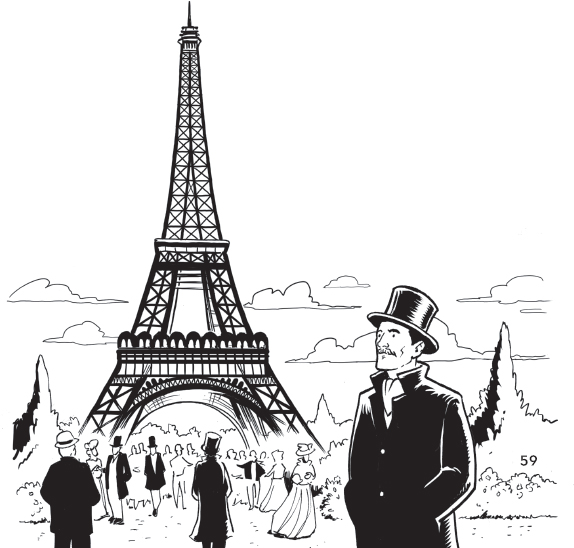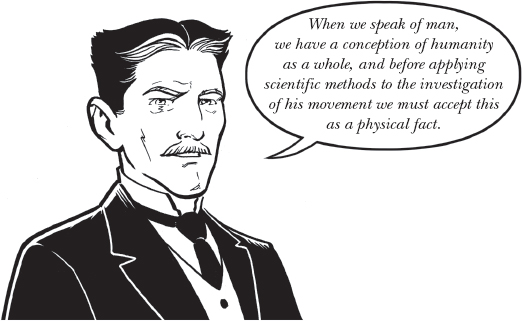

ON OCTOBER 28, 1886, President Grover Cleveland officiated at the dedication of Frederic Auguste Bartholdi's great statue, “Liberty Enlightening the World”—now widely known as the Statue of Liberty—in New York Harbor. Not far away in Lower Manhattan, Tesla's Liberty Street lab soon became a hotbed of design, patent applications, and the construction of various AC induction motors. It was work that would keep Tesla awake around the clock for days on end.
In May 1887, Tesla recruited his old friend and associate from Budapest, Anthony Szigeti (who had witnessed Tesla's early sand drawings of an induction motor almost five years earlier) to assist with production. As his ship sailed past the outstretched torch of Lady Liberty, Szigeti's grandest dreams of success could hardly have anticipated what lay ahead. Along with engineer Alfred Brown, who provided technical input, Tesla and Szigeti would forge an alliance to free the world from the constraints of DC.
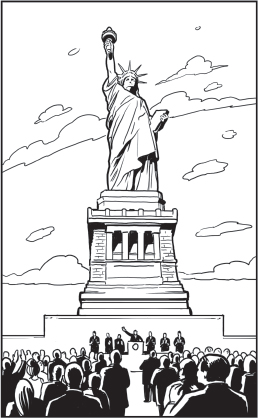
Now that funds were raised for research and development, it was an opportune time to bring Tesla's induction motor to the attention of the electrical engineering establishment. First, Peck and Brown would need to vet the machine with a prominent electrical engineer and physicist before they could realize any profit. They found the right person in Professor William A. Anthony of Cornell University, who subjected two motors—one AC, one DC—to intense scrutiny. According to Professor Anthony's report, the efficiency of Tesla's AC motor was equal to that of the best DC motor.
Second, Peck and Brown were anxious to reach out to the electrical community at-large. With Professor Anthony's glowing review, it was easy to attract the attention of Thomas Commerford Martin, the editor of America's premier electrical magazine, Electrical World, as well as president of the American Institute of Electrical Engineering (AIEE). His endorsement would be key to Tesla's success in America.
After a demonstration of Tesla's apparatus at the Liberty Street lab, Martin suggested that Tesla prepare a lecture for other noted electricians. Tesla refused at first, but when his first seven patents were granted on May 1, 1888, Martin approached him again.
An Englishman educated as a theologian, Martin came to the United States with Old World manners and a close familiarity with the spread of electricity. He had stood beside his father in the laying of the first telegraph cable under the Atlantic Ocean with British physicist Lord Kelvin and others. Martin was the same age as Tesla and shared a common interest in electrical research. Upon his arrival in New York in 1877 he, too, had gone to work for Edison.
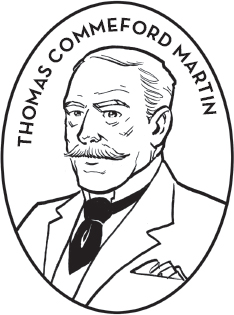
After the demonstration at Liberty Street, Martin was convinced that Tesla's inventions in the utilization of polyphase currents would show how thoroughly the inventor had mastered the fundamental concept and could apply it in the greatest variety of ways. Martin persisted in asking Tesla to deliver a lecture to the community of electrical engineers, knowing it would prove that motors no longer required brushes and commutators.
Despite being overworked and in poor health, Tesla succumbed to Martin's persuasive powers (so much so, in fact, that he eventually gave Martin approval to re-publish all of his papers that had been read before technical societies in the United States and Europe over the next decade). Overnight he wrote out his AIEE lecture in longhand. The following day, May 16, 1888, at Columbia College, he delivered his milestone paper, “A New System of Alternate Current Motors and Transformers.”
Imagine the setting: Tesla, dressed impeccably as always, standing tall over two motors set up for demonstration. He speaks perfect English, perhaps with a slight accent (there is no known recording of his voice). Gathered before him sits an assemblage of skeptical, starch-collared electrical engineers. If archival pictures from the period are any indication, they are a formidable lot. Tesla addressed them as follows:
The subject which I now have the pleasure of bringing to your notice is a novel system of electric distribution and transmission of power by means of alternating currents, affording peculiar advantages, particularly in the way of motors, which I am confident will at once establish the superior adaptability of these currents to the transmission of power and will show that many results heretofore unattainable can be reached by their use; results which are very much desired in the practical operation of such systems, and which cannot be accomplished by means of continuous currents.
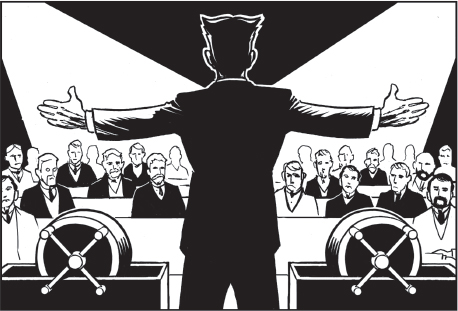
Tesla went on to explain that commutators are useless in a motor because they unnecessarily reverse electrical currents. He supported his presentation with a series of diagrams detailing the step-by-step, back-and-forth magnetic flow of electricity in his Electro-Magnetic Motor. The patent for it, Number 381,968, had been approved just two weeks prior to the lecture.
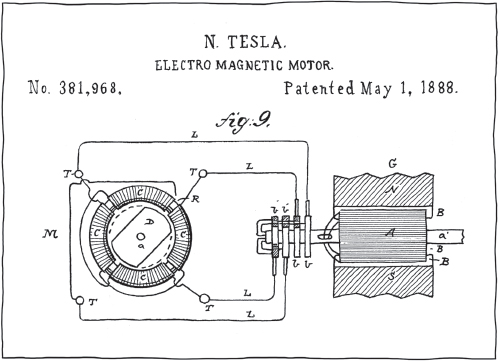
It was a convincing demonstration of how two alternating currents can create a rotating magnetic field and, alternatively, how the rotating magnetic field exerts a uniform pull on the motor's rotor. To be sure, he backed up the demonstration with a full mathematical analysis of how all this was accomplished. He then described a basic polyphase motor, which consisted of a ring with four separate coils for the stator (which remains fixed with respect to rotating parts) and the steel disc rotor. So clear and persuasive was Tesla's lecture that the engineering community was able to absorb the new principles as if they knew his theories all along.
As is often the case with any invention or new theory, however, there is always someone else who claims to have had the idea first or who refuses to let go of established ways of thinking. Tesla's challengers were at the ready, poised to nip away when the floor was opened to discussion.
Professor Elihu Thomson, a prominent electrical engineer and inventor, took the bait. He stood up to make the case against the polyphase motor. Tesla, no one's pushover, responded in a courtly manner by emphasizing the unnecessary use of commutators. Thompson was incensed and remained forever at odds with Nikola Tesla.
While the exchange demonstrated the high degree of competitiveness among electrical engineers and inventors, it served Peck, Brown, and Tesla's desired purpose. The effect was to set the electrical community abuzz, opening the door for the third component of their business strategy: to sell or license the patents.
With guile, shrewdness, subterfuge, or smoke and mirrors—call it what you will—Peck and Brown were determined to get the best deal possible for Tesla's invention. Certainly there were profiteers who recognized the potential of owning Tesla's patents. Controlling the distribution of electrical power was irresistible to egomaniacal entrepreneurs, as exemplified by Edison's quest to corner the market on direct current. The rush to control the flow of electricity to homes and factories was in full-throttle. Tesla's system changed the whole playing field.
George Westinghouse, an industrialist and inventor, had earned a fortune from his invention of railroad air brakes (patented 1869). So successful was this invention that the Railroad Safety Appliance Act of 1893 made air brakes compulsory on all American trains; they also became standard in Europe. Westinghouse also pursued the development of electronic railroad signaling devices and standardization across all railway systems.
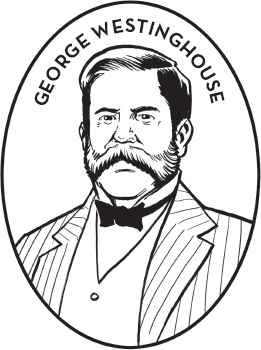
For many successful inventors, including Edison, groundbreaking work is predicated on the achievements of others. As George Westinghouse built his empire, he purchased a number of devices and patents from Granville T. Woods, who had filed over 50 patents in his own right but lacked the business savvy or social standing to make the most of them.
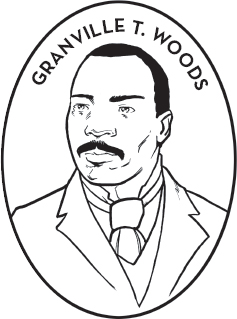
Westinghouse was no stranger to alternating current and recognized its potential. He had acquired the patents to an early AC distribution system pioneered by the French scientist Lucien Gaulard and English engineer John Dixon Gibbs. With Gaulard-Gibbs transformers and a Siemens AC generator, Westinghouse sought to install an electrical system for the city of Pittsburgh, Pennsylvania. Getting such a system up and running posed enormous challenges. In 1886, he incorporated the Westinghouse Electric Company in direct opposition to Edison's DC system; three years later, he renamed his firm the Westinghouse Electric & Manufacturing Company.
Tesla's AIEE speech captured the attention of George Westinghouse, who directed his staff of engineers to investigate Tesla's motors. Rather than have them try to copy or modify his design, Westinghouse began negotiating with Peck and Brown for the patent rights to Tesla's motor and AC system. He was firm in his conviction that the future lay not only in AC lighting but in AC motors and transformers that could step up and step down the voltage as required. Westinghouse was ready to invest—and heavily—in Tesla's technology. For starts, he had his scientific associates and legal team trying to corner the market on Tesla's motor and patents.
After weeks of negotiation, Peck, Brown, and Tesla were able to secure a favorable deal with Westinghouse for the motor patents. The industrialist agreed to pay $20,000 in cash and $50,000 in Westinghouse stock, plus a $2.50 royalty per horsepower on every Tesla motor; there would be a $5,000 minimum royalty payment in the first year, $10,000 the second year, and $15,000 the third year. Commenting on the deal, Westinghouse said,
With reference to the Tesla motor patents, the price to be paid seems rather high when coupled with all of the other terms and conditions, but if it is the only practicable method for operating a motor by the alternating current, and if it is applicable to street car work, we can unquestionably easily get from the users of the apparatus whatever tax is put upon it by the inventors.
Tesla had great respect for Westinghouse, who, after all, believed in the AC system. With characteristic munificence, Tesla was willing to divide proceeds of the sale, retaining four-ninths for himself while granting five-ninths to Peck and Brown for their efforts.
That summer, Tesla moved to Pittsburgh to help at the Westinghouse plant with the development of motors and the city's power system. With his newfound cash flow, Tesla began his life-long residency in hotels. It was a lifestyle that befitted his status, wealth, temperament, and permanent bachelor status. His trusted friend and assistant Szigeti remained behind to test out new machines in the Liberty Street lab.
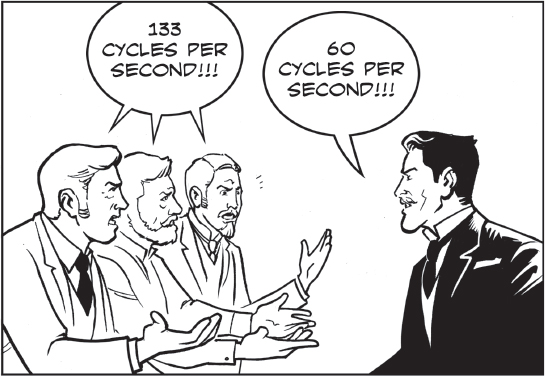
Not all of his colleagues at Westinghouse were entirely receptive to Tesla's radical new system. They had long run their motors at 133 cycles per second and resisted Tesla's proposal to run on a frequency of only 60 cycles per second. It was a frustrating period for him, as he wasted valuable time trying to adapt Westinghouse's motors to his proposed frequency. It prevented Tesla from new research for months on end before the Westinghouse staff finally accepted his proposal to run at the lower frequency and make their motors practical. Sixty cycles per second, or 60 Hertz (written as 60 Hz), remains standard to the present today.
In late summer 1889, after a year in Pittsburgh, Tesla returned to New York for a short stay, primarily to set up his second lab at 175 Grand Street. That September, he went to see the recently unveiled Eiffel Tower at the Paris World Exposition, to lecture in Europe, and to visit his family in Serbia.
By acquiring the Tesla AC motor, Westinghouse was positioning himself for success on a large scale. Edison was rightly nervous that this posed a major threat to his business built on DC. The result was the so-called War of the Currents. Edison fired the first salvo by initiating a propaganda battle, citing safety concerns over the high voltage utilized in AC systems. Demonstrations were organized to dissuade users from adopting alternating current over Edison's tried-and-true direct current. Edison would not hold back in trying to protect his technology and his profits, going so far as to suggest that electricity—AC in particular—kills. He had invested enormous sums of money to build DC generating stations and networks of copper wire every few city blocks, covering about a half-mile, to deliver electricity underground. By 1890, however, that distance paled by comparison to Westinghouse's installation of a 12-mile, 4000-volt AC transmission line from Willamette Falls to Portland, Oregon.
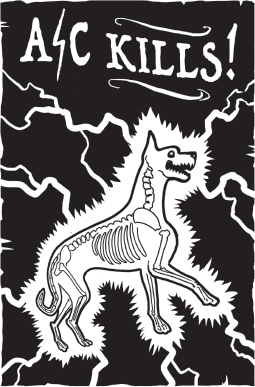
Enter Harold P. Brown, a New York engineer and electrical consultant who endeared himself to Edison's cause by publishing articles on the dubious merits of AC. Brown went so far as to offer 25 cents for every dog and cat rounded up for public electrocution by being wired to an AC generating motor. The demonstrations would start by wiring a dog to a DC generator and slowly raising the voltage, from a low point that caused the dog mild annoyance to a high point, close to 700 volts, at which the animal broke loose from the wire restraints. The upper level was not enough to kill the dog but still tortuous, and onlookers denounced the exercise. Brown used that moment to further his anti-AC crusade, arguing that that he could put the dog out of its misery by switching to alternating current. As he demonstrated on stage, a quick jolt of 300-volts of AC brought about the quick death of the dog. Had the initial DC charges so thoroughly weakened the animal that it only took the final AC charge? In reality the demonstration did not prove that AC was any more lethal than DC, but it strengthened that perception and helped affirm Edison's position in the public's eye.
Although it is not completely clear what motivated Brown to electrocute dogs and cats, we do know that he was employed by Edison and that he was seeking a more humane method of executing violent criminals. Edison himself later attended hearings that spurred the New York State Legislature to adopt the electric chair for capital punishment. Westinghouse was outraged, regarding the campaign as part of the propaganda war against AC.
With Edison's endorsement, Brown was appointed as New York's electrocution expert and wasted little time in having a Westinghouse generator installed at Auburn State Prison. The first legal execution by electrocution took place there on August 6, 1890, with Brown in attendance. The execution did not go at all smoothly. After a succession of clumsy attempts, convicted murderer William Kemmler finally succumbed to increased dosages of AC electricity. It was a grisly affair, roundly denounced in newspapers the next day.
Proponents of DC, missing no opportunity to promote their cause, took to saying that Kemmler had been “Westinghoused.” George Westinghouse himself said, “I do not care to talk about it. It has been a brutal affair. They could have done better with an axe.” Tesla, an ardent humanitarian, in later years expressed his abhorrence of electrical execution. Harold Brown, with all the brouhaha over his demonstrations, quietly disappeared from the War of the Currents. And Edison, still seething from his battle against Westinghouse, continued to discredit his adversary for years. In one last jab, in January 1903, Edison filmed a six-ton elephant named Topsy being publicly electrocuted at Coney Island in New York. By that time, the War of the Currents was long over and Tesla's AC system had been accepted worldwide.
In the meantime, Edison's early campaign against alternating current rocked Westinghouse's investors. Production of Tesla's induction motors ground to a standstill in 1899 and would not continue until after Tesla returned from Paris.
While work had stopped in Pittsburgh, the Grand Street lab was abuzz. Before departing for Paris, Tesla had begun early experiments in high-frequency apparatus, the relationship between electromagnetic radiation and light, and what would become his lifelong obsession, the wireless transmission of energy.
Barely five years after arriving in the United States with four cents in his pocket, Tesla at age 33 was a wealthy man and could sail to Paris in style. The great attraction there was the Exposition Universelle, or Paris World's Fair, and its controversial modernist centerpiece, the Eiffel Tower. Also on display at the exposition would be a number of new electrical exhibits and inventions, including the introduction of an Edison phonograph for the general public. While Edison was being lauded and celebrated by European dignitaries, Tesla had other things on his mind. He hoped, for example, that the Exposition might be an opportunity for him to catch up on the latest news in the field of electrical vibration regarding the relationship between alternating current and light waves. Here was his chance to confer with the most advanced theorists in Europe.
During his stay in Paris, Tesla was also able to meet with the young Norwegian mathematician and physicist Vilhelm Bjerknes. It was an auspicious meeting, as Bjerknes had collaborated with French mathematician Jules-Henri Poincaré in reproducing the experiments and had worked out the mathematics that confirmed the findings of German physicist Heinrich Hertz on the propagation of electromagnetic waves through space. For Tesla, the visit was an opportunity to study Bjerknes's oscillator, which provided a variety of electromagnetic waves and a resonator for augmenting them. Further, he discussed theoretical implications concerning the properties of the resulting electromagnetic waves. From these discussions, Tesla discovered that the electromagnetic waves, or Hertzian waves not only produce transverse oscillations, but also longitudinal vibrations structured much like sound waves. According to Tesla biographer Marc J. Seifer, these findings would be instrumental in Tesla's work over the next decade in his construction of wireless transmitters. It would lead to one of his most important discoveries: the radio.
